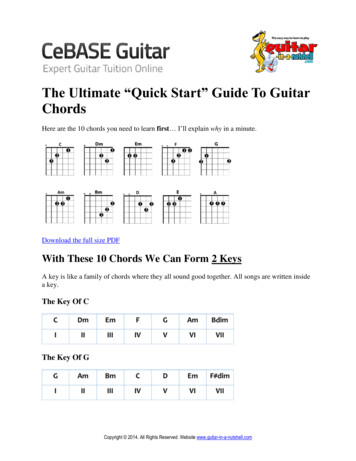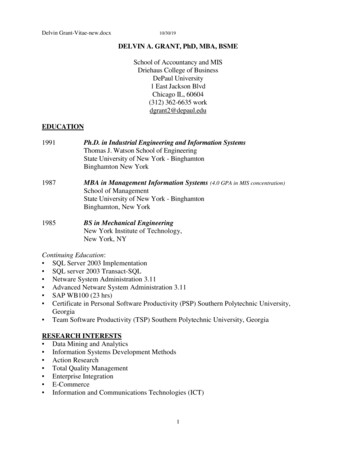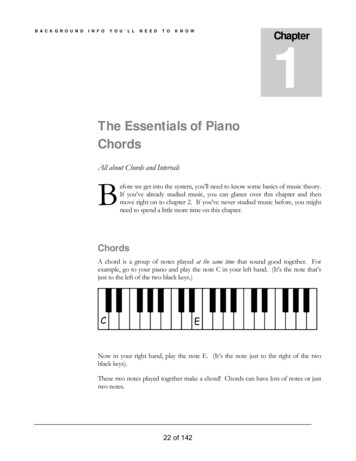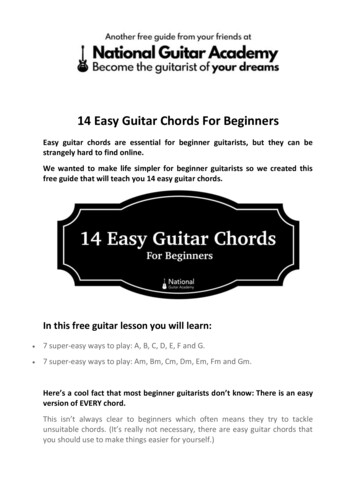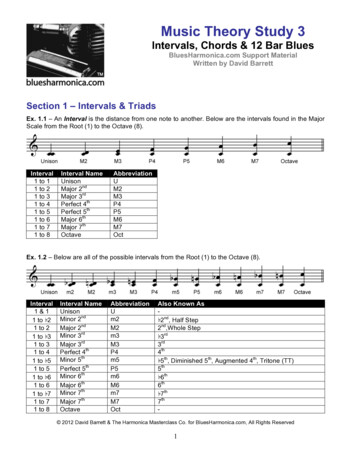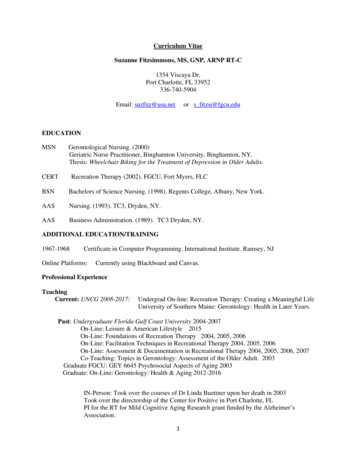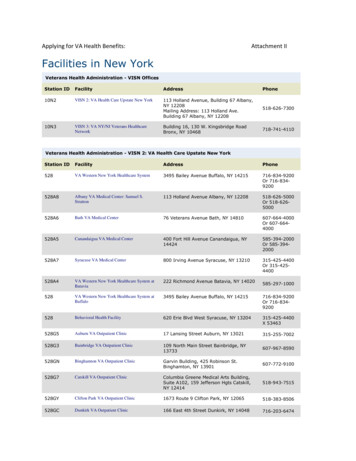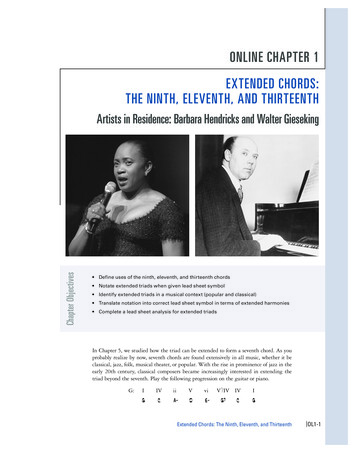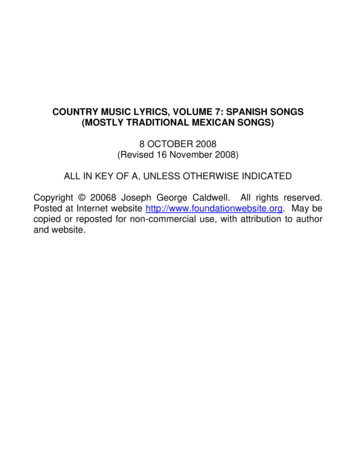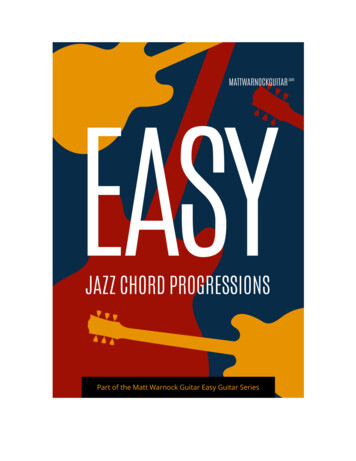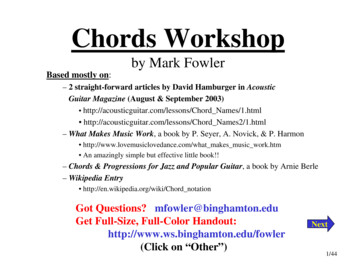
Transcription
Chords Workshopby Mark FowlerBased mostly on:– 2 straight-forward articles by David Hamburger in AcousticGuitar Magazine (August & September 2003) http://acousticguitar.com/lessons/Chord Names/1.html http://acousticguitar.com/lessons/Chord Names2/1.html– What Makes Music Work, a book by P. Seyer, A. Novick, & P. Harmon http://www.lovemusiclovedance.com/what makes music work.htm An amazingly simple but effective little book!!– Chords & Progressions for Jazz and Popular Guitar, a book by Arnie Berle– Wikipedia Entry http://en.wikipedia.org/wiki/Chord notationGot Questions? mfowler@binghamton.eduGet Full-Size, Full-Color Handout:http://www.ws.binghamton.edu/fowler(Click on “Other”)Next1/44
What We’ll Cover Part Ia– What notes are in the “normal” chords? Part Ib– What notes are in the “weird” chords? Part II– How do you play the “weird” chords? Part III– When do you use the “weird” chords?Next2/44
Part IaWhat Notes Are In The“Normal” Chords?Next3/44
What is a Chord? Three or more different notes played togetherWhat Makes a Certain Chord? It depends on the “Intervals” (i.e., distance) betweenthe notesWhat Is an Interval? A measure of the distance between two notes Interval names are based on positions in scales– Actually, they are really based on the # of “half steps”between the notesNote: 2 notes a half stepapart are one fret apartNext4/44
Intervals within the C Major Scale“b7th”(Minor ct 4thHMinor3rdMajor3rdEWEbDWC#CMajor2ndNext5/44
Intervals Between Strings On The Guitar¾ 4thsA 4th “up” isa 5th “down”¾ 5thsAdjacent Strgs¾ Maj 3rds¾ Min 3rdsSkipped StrgsNext6/44
Triads – Simplest ChordsThere are only 4 types of triads:¾ Major¾ MinorR35R b3 5¾ Diminished¾ AugmentedR b3 b5R 3 Perfect 5thMajor 3rdFEEbDC#Perfect 5thMinor 3rdCThese constitute about 99% of the chordsyou see traditionally in a fiddle tuneFEEbDC#CFlat 5thMinor 3rdFEEbDC#Sharp 5thMajor 3rdCWe won’t be needing these!Next7/44
Triads-Based Guitar Chords: An ExampleC MinorC Major4 1 0 1 x3 2 0 1 0Note: In a typical GuitarChord-Form we oftenrepeat triad notesCEGCER 35 R3¾ MajorR35C Eb G CR b3 5 R¾ MinorR b3 5CCBBbAG#GGbBBbAG#GGbFEEbDC#CPerfect 5thMajor 3rdFEEbDC#CPerfect 5thMinor 3rdNext8/44
Triads-Based Guitar Chords: Another ExampleD MajorD Minor0 0 1 3 20 0 2 3 1In some Guitar ChordForms the triad notes don’tappear “in order”A D A D F#5 R5R 3ADADF5 R 5 R b3¾ MajorR35¾ MinorR b3 5DC#CDC#CBBbAG#GF#BBbFEEbDPerfect 5thPerfect 5thAMajor 3rdG#GF#FEEbDMinor 3rdNext9/44
Part IbWhat Notes Are In These“Weird” Chords?Next10/44
Bigger Intervals(shown relative to C in C major scale)C1D2E F3 4G A5 6B7C8D E F G A B C9 10 11 12 13 14 15Next11/44
Nearly-Complete Jazz Chord “Family Tree”For Jazz Chords: sequentially add other notes to a maj/min triadNote the main pattern: 1 3 5 7 9 11 13b3b7Major TriadAdd 6These are the“Dominants”Add b7Add 7Add 6Add b7Maj71 35771 3 5 b7m615 6m(maj7)1 b3 5 7Maj6/913569Maj91357991 3 5 b7 9m6/91 b3 5 6 9m(maj9)1 b3 5 7 9Maj131 3 5 7 9 (11) 13111 (3) 5 b7 9 11131 3 5 b7 9 (11) 13b3Add bb7Add 7Maj61 356Maj111 (3) 5 7 9 11Dim TriadMinor TriadNotes in ( ) areusually omitted.It is common toleave out othernotes too,especially onguitarm71 5 b7b3dim 71 b3 b5 bb7m95 b7 91b31b3m115 b7 9 111b3m1359 (11) 13 6!!b7Altered Chords (e.g., A7#5b9): Raise or Lower the 5, 9, 11, or 13Next12/44
Part IIHow Do You Play These“Weird” Chords?Next13/44
An ExampleC7C Major3 2 0 1 03 2 4 1 xC E Bb CR 3 b7 RCEG CER 35 R 3¾ MajorR 3 5 b7CCBBbAG#GGbBBbAG#GGbFEEbDC#CMajor 3rd3 2 4 1 x¾ Dom 7R35Perfect 5thFor thisform wesacrificethe 5th !This nowbecomes“Movable”D7FEEbDC#Cb7thD F# C DR 3 b7 RE7Perfect 5th3 2 4 1 xVMajor 3rdE G# D ER 3 b7 RNext14/44
A Structure-Based Approach:AAMaj7A70 2 1 3 00 2 1 3 00 2 0 3 0A E A C# ER5 R3 5A E G# C# ER5 73 5A E G C# ER 5 b7 3 5CCMaj7C71 2 3 4 11 3 2 4 11 3 1 4 1Find a Root andKeep Lowering ItMake It Movable:IIIIIICGC EGR5 R 3 5IIICGB EGR5 7 3 5C G Bb E GR 5 b7 3 5Next15/44
More Examples of that Rule:GGmaj7G7Find a Root andKeep Lowering ItG63 2 0 0 0 43 2 0 0 0 13 2 0 0 0 13 2 0 0 0 0GB DGBGR 3 5 R 3RG B D G B F#R 3 5 R 37GB DGBFR 3 5 R 3 b7GB DGBER 3 5 R 36DDmaj7D7D60 0 1 3 20 0 1 1 10 0 2 1 30 0 2 0 3A D A D F#5 R 5 R 3A D A C # F#5 R 5 7 3A D A C F#5 R 5 b7 3A D A C F#5 R 5 6 3Next16/44
Another Structure-Based Rule:G6G1 3 4 2 1 1IIIG71 3 x 2 1 11 3 x 2 1 1GDR 5GDR 5Find a 5th andKeep Raising ItIIIGDGB DGR 5R 3 5RB EG3 6RB F G3 b7 ROr Use Our 1st Rule:Lowering a RootG1Gmaj74 3 21III4 2 1IIIGDGB DGR 5R 3 5RG712 4 3IIIGRF# B D7 3 5G621 4 3GRE BD6 3 5IIIGRF BD3 5b7Gray Circles notes left out to make the newchords playable playable!!!Next17/44
And More:A1 3 4 2 1 1VA E A C# E AR 5R 3 5RFind the Maj 3rdand lower itAmmaj7Am1 3 4 1 1 1V1 3 2 1 1 1AEA C EAR 5 R b3 5 R2 x 1 3 3 31 3 1 1 1 1VVAm6Am7A E G# C E AR 5 7 b3 5 RVAEG C EAR 5 b7 b3 5 RA F# C E AR 6 b3 5 R2 x 3 3 3 3Find a Root andkeep lowering itVARG C EA5R“CertifiedJazzer’sForm”Nextb7 b318/44
Another Rule: Making the dom 9th ChordC7Find a Root and Raise It3 2 4 1 x¾ Dom 9R 3 5 b7 9DC#9thC E Bb CR 3 b7 RRecall:For thisform wesacrificedthe 5th !This form is movableD92 1 3 3 3IVCBBbAG#GGbb7thFEEbDC#3rdCC92 1 3 4 xC9D F# C E AR 3 b7 9 52 1 3 3 35thE92 1 3 3 3VC E Bb DR 3 b7 9Here wegain backthe 5th !C E Bb D GR 3 b7 9 5E G# D F# BR 3 b7 9 5Next19/44
Part IIIHow Do You Use These“Weird” Chords?Next20/44
Triads Harmonize the ScaleChoose triad type so that each chord uses only scale bF3rdb3rdBbAG#GFEEbF5th5thBNext21/44
Typical Places to Use Jazz ChordsRecall: Number System for Chords (Example - Key of G)I ii iii IV V vi viiG Am Bm CD Em F#oJazzy ReplacementsIMaj7, Maj6 ( in blues the I is played as Dom7)IVMaj7, Maj6, ( in blues the IV is played as Dom7)VDom7ii, iii, vimin7To see why see next two slides Numbered Chords with Replacements:IiiiiiIVVGM7 Am7 Bm7 CM7 D7viEm7viiF#o7Next22/44
Pick Extensions to Stay in ScaleWhy I is either Maj7 or Maj6:I:Gmaj7I:Gmaj6Why IV is either Maj7 or Maj6:IV:Cmaj7IV:Cmaj6Maj 7thBBbAG#GF#Maj 7thGGF#F#FFEEbEEbDC#CBBbAG#G5th3rdDC#CBBbAG#GMaj 6th5th3rdBBbAG#5thFEEbGF#Maj 6th5thF3rdEEbDDC#CC#CBBbAG#GBBbAG#G3rdNext23/44
Pick Extensions to Stay in ScaleWhy the V chord is Dom7:Why ii, iii & iv chords are bb3rdDC#CBBbAG#GNext24/44
Golden Slippers in G: Standard ProgressionLet’s use our replacement rules (and a couple otherjazz ideas) to spice up the chords for this tune .IVIA Part: G / / / / / / / / / / / D / / / / / / / / / / / G / / / IIVVIB Part: G / / / / / / / C / / / / / / / D / / / / / / / G / / / / / / / IVVII G/// //// C/// //// D/// //// //// G/// A good place to start is with the V chords Next25/44
First Step: Change V to dom7Jazzy ReplacementsIMaj7, Maj6 ( in blues the I is played as Dom7)IVMaj7, Maj6, ( in blues the IV is played as Dom7)VDom7ii, iii, vimin7This first step doesn’t make things too jazzyNext26/44
Some Jazz Dom7 Chord Forms for the V in GD7D7D713 2 4 1 x1 3 1 4 12 4 3This one isn’t quiteas “jazzer-approved”as the other twoVXIIID F# C DR 3 b7 RDRC F# Ab7 3 5D A C F# AR 5 b7 3 5A simpler form to use for now but itjust doesn’t have that nice jazz texture:D70 0 2 1 3A D A C F#5 R 5 b7 3Next27/44
Golden Slippers in G: w/ Dom 7th on VCould use this, for nowD7D73IVIA Part: G / / / / / / / / / / / D7 / / / / / / / / / / / G / / / Could use this, for nowD7D73IIVVIB Part: G / / / / / / / C / / / / / / / D7 / / / / / / / G / / / / / / / IVVII G / / / / / / / C / / / / / / / D7 / / / / / / / / / / / G / / / Next28/44
Second Step: Change I to Maj6Jazzy ReplacementsIMaj7, Maj6 ( in blues the I is played as Dom7)IVMaj7, Maj6, ( in blues the IV is played as Dom7)VDom7ii, iii, vimin7Changing the I chord to Maj7 makes thingsvery “loungy-jazzy” not so good forfiddle tunes.Changing the I chord to Maj6 makes thingsmore “western-swingy-jazzy”Next29/44
Some Jazz Maj6 Chord Forms for the I in GG6G61 3 x 2 1 1III21 4 3GRE BD6 3 5IIIGDR 5B EG3 6RLeave out thegray circles they are thereonly to showwhere thiscame from!A simpler form to use for now but itjust doesn’t have that nice jazz texture:G63 2 0 0 0 0GB DGBER 3 5 R 36Next30/44
Golden Slippers in G: w/ Maj 6th on I3G6G61 3 x 2 413 2 0 0 00Could use this, for nowD7Could use this, for nowIVIA Part: G6 / / / / / / / / / / / D7 / / / / / / / / / / / G6 / / / IIVVIB Part: G6 / / / / / / / C / / / / / / / D7 / / / / / / / G6 / / / / / / / IVVII G6 / / / / / / / C / / / / / / / D7 / / / / / / / / / / / G6 / / / Next31/44
3rd Step: Change IV to Maj6 with a “twist”Jazzy ReplacementsIMaj7, Maj6 ( in blues the I is played as Dom7)IVMaj7, Maj6, ( in blues the IV is played as Dom7)VDom7ii, iii, vimin7Changing the IV chord to Maj6 gives: C6 C E G ABut imagine re-arranging these same notes:AECGHey that is an Am7 which is the iim7 of G!!!Can substitute iim7 for IVmaj6!!!Next32/44
Some Jazz min7 Chord Forms for the ii in GAm7Am72 x 3 3 3 3x 0 3 3 3 3VVARG C EA5Rb7 b3A G C EAR b7 b3 5 RA simpler form to use for now but itjust doesn’t have that nice jazz texture:Am7x 0 2 0 1 0A E G CER 5 b7 b3 5Next33/44
Golden Slippers in G: w/ ii min7th sub for IVG63 2 0 0 00for nowIVIA Part: G6 / / / / / / / / / / / D7 / / / / / / / / / / / G6 / / / G6for nowfor now3 2 0 0 00Am7Am72 x 3 3 33x 0 2 0 10D7for now5Iii7VIB Part: G6 / / / / / / / Am7 / / / / / / / D7 / / / / / / / G6 / / / / / / / VIii7I G6 / / / / / / / Am7 / / / / / / / D7 / / / / / / / / / / / G6 / / / Next34/44
4th Step: Insert Passing ChordsFor now lets forget that we substituted iim7 for IV6Notice how in the B part we have IV C going up to V D:IIVVIB Part: G6 / / / / / / / C / / / / / / / D7 / / / / / / / G6 / / / / / / / IVVII G6 / / / / / / / C / / / / / / / D7 / / / / / / / / / / / G6 / / / A cool thing would be to go chromatically up through C#!!But what chord type?!!Next35/44
Dim7 Chord FormsSo let’s take a C7 chord and move the root up to a C# but leaveeverything else the same that gives us a “passing chord” thatprovides some chromatic motion:C7C#o71 3 1 4 11 3 1 4 1IIIIIIC G Bb E GR 5 b7 3 5C7C# G Bb ER b5 bb7 b3Everything but theroot from a C7chord plus the C#C#o73 2 4 1 x3 2 4 1 xBbBbCool Things about Dim7 Chords1. Root can be taken asANY note in the chord.2.CE CR 3 b7 RC# GEb3 bb7 R b3Shift it three frets and you get thesame chord again!!!Next36/44
Golden Slippers in G: w/ dim7 passing chordsExample #1IVIA Part: G / / / / / / / / / / / D7 / / / / / / / / / / / G / / / C# 7C# 7Could use this, for now3IIVIV# 7IB Part: G / / / / / / / C / / / / / C# 7 / D7 / / / / / / / G / / / / / / / IV# 7 VIVII G / / / / / / / C / / / / / C# 7 / D7 / / / / / / / / / / / G / / / Next37/44
4th Step Revisited: Insert Passing ChordsBut we substituted iim7 for IV6 So our B part looks like this:VIIii7B Part: G6 / / / / / / / Am7 / / / / / / / D7 / / / / / / / G6 / / / / / / / ii7VII G6 / / / / / / / Am7 / / / / / / / D7 / / / / / / / / / / / G6 / / / A cool thing would be to go chromatically up through G#!!But what chord type?!!G71G#o72 4 3III21 3 1G7G#o70 0 0 20 1 0 2D GBF5 R 3 b7NextIIIGRF BD3 5b738/44
Golden Slippers in G: w/ dim7 passing chordsG63 2 0 0 00D7for nowExample #2for nowIVIA Part: G6 / / / / / / / / / / / D7 / / / / / / / / / / / G6 / / / for nowAm7for nowG63 2 0 0 00IG# 7x x 0 1 02I# 7x 0 2 0 10for nowD7for nowii7VIB Part: G6 / / / / / G# 7 / Am7 / / / / / / / D7 / / / / / / / G6 / / / / / / / ii7VI G6 / / / / / G# 7 / Am7 / / / / / / / D7 / / / / / / / / / / / G6 / / / II# 7Next39/44
5th Step: Further Jazzify the ChordsOur first step didn’t make things too jazzyWe made the V chords dom7 Jazzy ReplacementsIMaj7, Maj6 ( in blues the I is played as Dom7)IVMaj7, Maj6, ( in blues the IV is played as Dom7)VDom7ii, iii, vimin7Now to make things even jazzier use jazzy extensions: add in the 9(& maybe 11, 13)Next40/44
A Jazz Dom9 Chord Forms for V in GD92 1 3 3 3IVD F# C E AR 3 b7 9 5A simpler form to use for now but itjust doesn’t have that jazz texture:D70 0 2 1 0ADAC E5 R 5 b7 9Next41/44
Golden Slippers in G: w/ Dom 9th on VG63 2 0 0 00for nowD9D9for now5IVIA Part: G6 / / / / / / / / / / / D9 / / / / / / / / / / / G6 / / / G63 2 0 0 00D9for nowD9for now5IIVVIB Part: G6 / / / / / / / C / / / / / / / D9 / / / / / / / G6 / / / / / / / IVVII G6 / / / / / / / C / / / / / / / D9 / / / / / / / / / / / G6 / / / Next42/44
Golden Slippers: “Complete”G6“For Now” FormsD9G63 2 0 0 003 2 0 0 00IVIA Part: G6 / / / / / / / / / / / D9 / / / / / / / / / / / G6 / / / The ii – V – I progression shows up all over in Jazz!!!G63 2 0 0 00IG# 7Am7x x 0 1 02x 0 2 0 10I# 7D9G63 2 0 0 00ii7VIB Part: G6 / / / / / G# 7 / Am7 / / / / / / / D9 / / / / / / / G6 / / / / / / / ii7VI G6 / / / / / G# 7 / Am7 / / / / / / / D9 / / / / / / / / / / / G6 / / / II# 7Next43/44
Golden Slippers: “Complete” “To Work On” FormsG6D9G6335IVIA Part: G6 / / / / / / / / / / / D9 / / / / / / / / / / / G6 / / / The ii – V – I progression shows up all over in Jazz!!!G63G# 7Am73355IG6D9I# 7ii7VIB Part: G6 / / / / / G# 7 / Am7 / / / / / / / D9 / / / / / / / G6 / / / / / / / ii7VI G6 / / / / / G# 7 / Am7 / / / / / / / D9 / / / / / / / / / / / G6 / / / II# 7STOP 44/44
For Jazz Chords: sequentially add other notes to a maj/min triad Maj6/9 1 3 5 6 9 Altered Chords (e.g., A7#5b9): Raise or Lower the 5, 9, 11, or 13 Maj11 1 (3) 5 7 9 11 Notes in ( ) are usually omitted. It is common to leave out other notes too, especially on guitar
